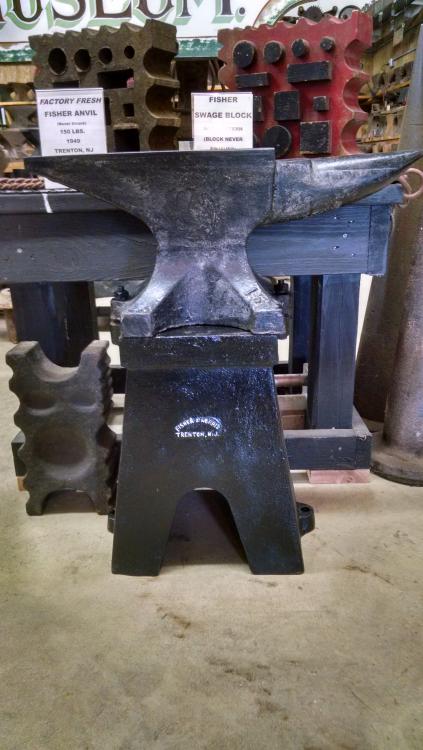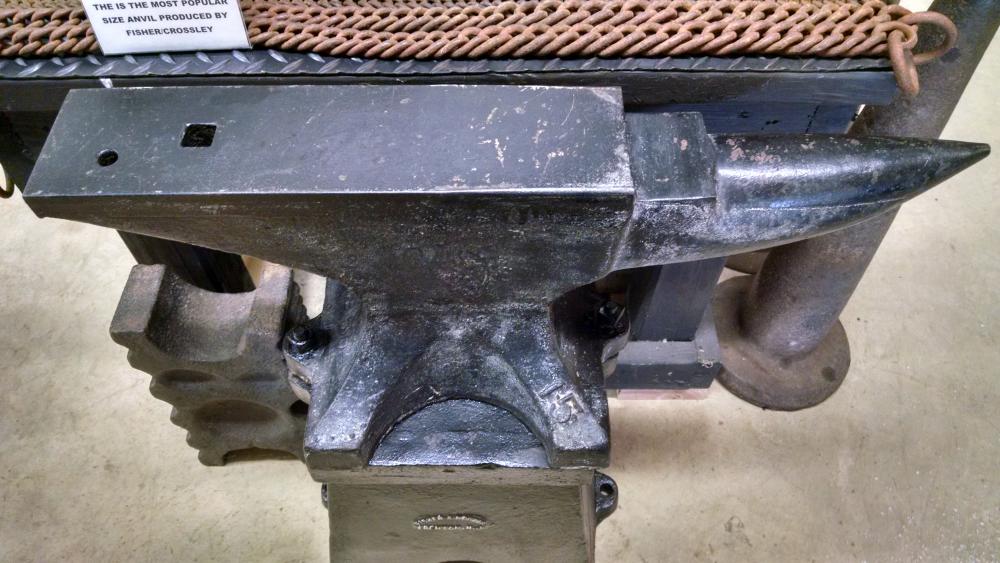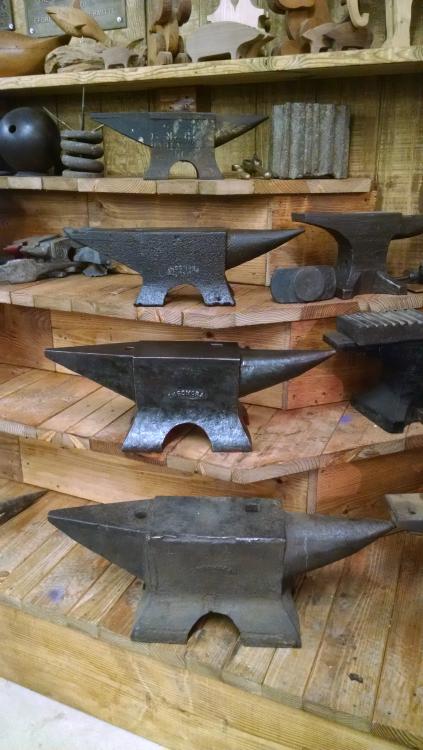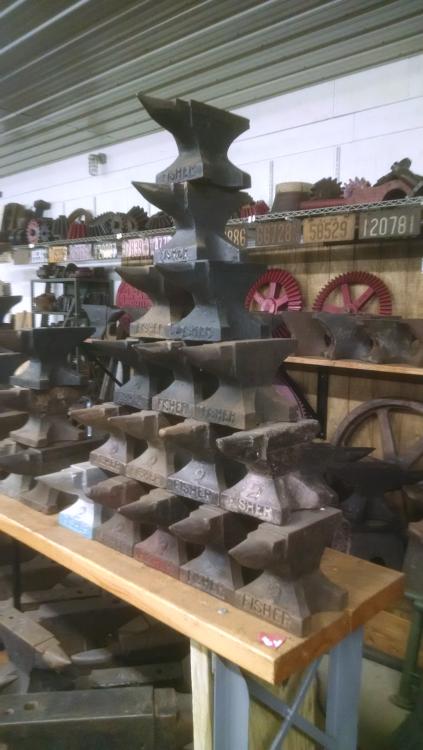-
Posts
2,481 -
Joined
-
Last visited
Content Type
Profiles
Forums
Articles
Gallery
Downloads
Events
Everything posted by njanvilman
-
That anvil was made by Fisher for the Blacker hammer. Many are being used alone. Pluses= very heavy duty. Two hardy holes. Its a BIG anvil. The Cool factor. The cutout portion. The cool base. Its a Fisher. Negatives= Working around the cut-out portion. The very thick heel. Big hardy holes. No pritchel hole. If the base is in the way, the anvil can always be removed and a custom base fabricated. Just keep the base. The combo is worth more than separate. These were made mostly in the 1920's. There 'might' be a serial number on the anvil. The $$ they are asking is generally the going price for these. I already have two in the museum or else I would have owned it already.
-
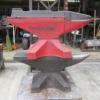
Giant School Project
njanvilman replied to MrDarkNebulah's topic in Blacksmithing, General Discussion
My former school now has this exact course as a senior elective. Not everyone has to do it. We had one student who was making duck calls make them out of many types of woods, then compared how they sounded and functioned. Practical, and he got it done in time. Most try to do too much and never finish. Frustration often set in. It is the task of the teacher to guide the students in the beginning to do a project that will provide for independent learning, and have a goal of where they want to end up. And setting that goal is always dependent on the students abilities,and the tools available to accomplish it. We always advised the students: KISS. "Keep it simple, stupid." Do not try to take on too much. This students first has to sort out his heating method. Coal/ charcoal/ propane. That alone could be the basis for part of the project. Compare the forges and what can be done in each? Then do some simple forgings. Maybe develop a whole series of different decorative twists. They could all just be samples. You do not have to build the Eiffel Tower. Asking for ideas is good, just keep it simple. -

Giant School Project
njanvilman replied to MrDarkNebulah's topic in Blacksmithing, General Discussion
As a retired shop teacher, I feel I must jump in here. This student must do a project on his own, one that he develops and executes. I am sure a journal record of what you do, learned and completed will be part of the presentation. This is not a group project. This is not a business. Come up with a plan with an end product in mind. Whether you achieve your goal is not the primary task; the journey and learning that takes place is what counts. If you have access to a forge, great. Do you access to cutting and welding equipment? Do you know how to use them? Primary consideration is to assess what you know and have the ability and equipment to do. Then, based on that, figure out where you want to go with it. And do not take on too big of a task. It is better to finish early and do some small extra skills, than get bogged down with a project you could never finish. -

Trying to find out about a strange anvil
njanvilman replied to Benh67's topic in Anvils, Swage Blocks, and Mandrels
It is part of a cast iron vise. -

Vulcan and Kohlswa anvil literature needed
njanvilman replied to Kozzy's topic in Anvils, Swage Blocks, and Mandrels
Vulcan anvils were made in a similar fashion as Fisher anvils: they are cast as one piece. What looks like a joint is just where the two parts of the pattern met in the mold. Some patternmaker's cleaned this up better than others. I 'might' have some literature on Vulcan. I will check. -

New to forum needed help anvil
njanvilman replied to Glm's topic in TPAAAT - Applied Anvil Acquisition Technique
The first anvil shown is definitely in better shape than the second one. Is it worth it? Depends on how much you want it. The price is reasonable in today's market. -
The earliest ones were marked on 4 sides, then they went to two sides, then one, and finally unmarked. Fisher first made the stands sometime after 1892, and they made them until they closed in 1979. Stands with 4 sides marked are getting rare, two sides turn up occasionally, one side is more common. Crossley era stands were not marked. Just wait till you see what is incoming.....
- 661 replies
-
- Cast anvil
- Fisher & Norris
-
(and 1 more)
Tagged with:
-
I recently acquired a nice Fisher stand with markings on two sides. I put it together with this 1949 Fisher, 150 lb anvil that has never been used or struck. Absolutely a 100 pt anvil. The pair make a great combination. This is what a FISHER anvil looks like that is factory new, factory paint.
- 661 replies
-
- Cast anvil
- Fisher & Norris
-
(and 1 more)
Tagged with:
-
FISHER Insonora Anvils, from the top, 32 kg, 50 kg, 90 kg, and 125 kg. These were made by Fisher from around 1918 to the early 1920's, primarily for the South American market. Most were exported, so it is rare to find one in the US. It has taken me many years to find these for the Fisher & Norris Factory Museum. The bottom one is the one in Anvils in America, pg 161. None of these anvils has much use. There are no records of how many or what sizes they made. If anyone has one of these, please post a photo with the weight, especially if it is a different size that what is shown here. Thanks. .
- 661 replies
-
- Cast anvil
- Fisher & Norris
-
(and 1 more)
Tagged with:
-
Current stack of 20 lb Fisher anvils in the Fisher & Norris Factory Museum. 16 of this style in this stack, all dating from around 1885 to 1920. 4 of the mid 1920's style next to it. Contact me for a personal tour if you are in NJ. Check out my Facebook page for the museum.
- 661 replies
-
- Cast anvil
- Fisher & Norris
-
(and 1 more)
Tagged with:
-
I have been to QS the last 4 years. Once on Tuesday, the rest arrival on Wednesday. This year will be Tuesday again. Early arrivals are always checking out new loads as they arrive. Some buying and selling does happen. A lot of BS and catching up with old friends happens too. There are no reserved spaces for tailgating or camping, so it is first come, first serve. Tailgating picks up all week as new people arrive. The most active days are Friday and Saturday. The best thing about the tailgating area is that there is enough room for everyone. Even those that just come in for one day on Friday or Saturday can always find a place to park and sell, even if that means just opening your car trunk. I stay in a local motel. My camping days are long behind me. I usually pick up a sandwich at Panera, and keep it in a cooler with ice from the motel, for lunch. Lots of places for dinner near the motels.
-

just joined... looking at a vulcan anvil?
njanvilman replied to 927xpert's topic in Anvils, Swage Blocks, and Mandrels
Yes, it is a Fisher. If there is no name on the front, it was probably made during the Crossley years, 1962 to 1979. Post some pictures of the other side, under the heel and I can tell you more. -
It looks like there are serial #s on the left front foot under that paint. Grab a wire wheel and clean it off. The # will tell you a lot about what you have.
-
That anvil is beyond cool. But it is 1500 miles away, and a tad pricey. But it does have that neat factor, and is in terrific shape.
-
William 1973: It is a Farrier's style PW. I have one identical, but about 50 lb lighter. The horn was the important part, so no cutting table needed. Your anvil is fine, not worn out.
-
But it has "character".
-
7A749 That anvil looks like a Hay Budden Farriers anvil. They made various sized clips. I think this one was called the "standard clip". They would custom forge any modification the customer wanted. The long tail "might" be custom or could just be their pattern. Not sure about the small stud though.
-
Those letters and number could have been done at some time by the current plant for inventory. See if there are any markings on the other side of the anvil.
-
I would always try to keep a paying job going while learning. Use your free time, evenings, and such to learn, practice and get experience. Many people love forged work, but fewer are willing to pay a fair amount for it. I always forge for fun and practice, and either keep or give away everything...because I am not dependent on the that.
-
I always wanted a scrap steel I beam cuttoff drop to drag around and call it vintage or something.....
-
Already answered via private message.
- 661 replies
-
- Cast anvil
- Fisher & Norris
-
(and 1 more)
Tagged with:

